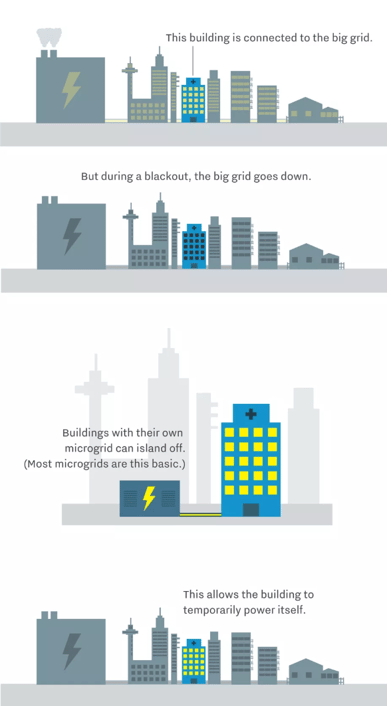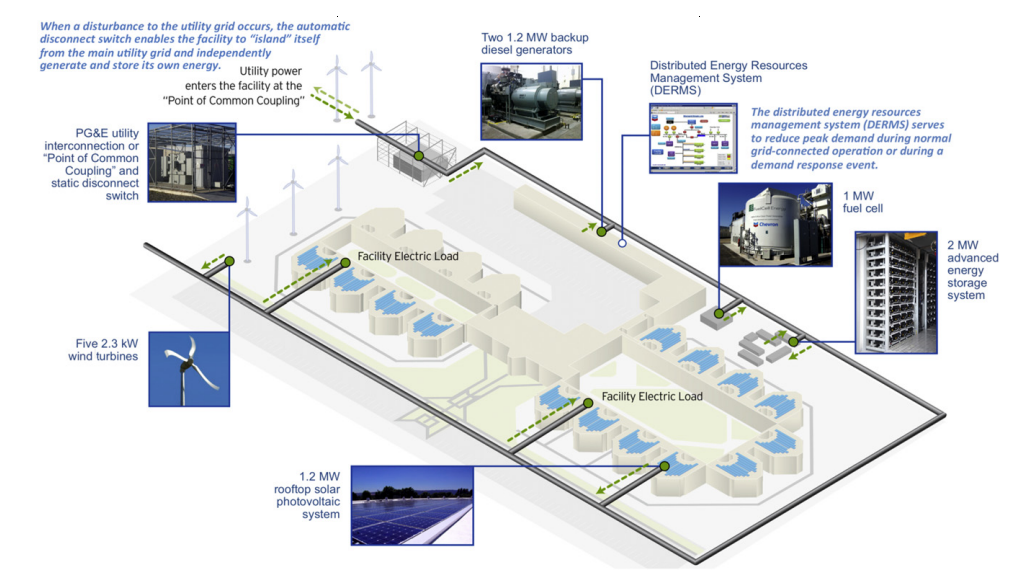Definition: What exactly is a “Microgrid?”
We've recently been getting a lot of questions from customers about microgrids. Microgrids are just what they sound like. Small, scaled down models of a standard electrical grid that may function as a sub-unit of a larger grid, or on its own as a “stand-alone” grid.
Microgrids boast three distinct benefits: convenience, customizability and cost. Sourcing energy from a smaller, less powerful grid can seem counterintuitive. But microgrids hold the potential to meet a farm or food processing operation’s precise energy needs with pinpoint accuracy as well as increased reliability.
This in turn can result in more efficiencies and economies of scale, leading to more energy, time and money saved.

Credit: Vox.com
Background: Where Did Microgrids Come From?
The term “microgrid” is relatively new. But microgrids have actually been around in the U.S. for over 100 years. The first was Thomas Edison’s combined heat and power (CHP) station in New York City that produced electricity and thermal energy/heating.
University campuses have been using microgrids for decades and feeding back into local utility grids when they produce excess power. In recent years, microgrids have gained popularity as a reliable source of power during and after natural disasters like hurricanes.

The Battery and Control Room in the first Edison Electric Lighting Station in 1882. Credit: Everett Historical/Shutterstock.com, Source: Microgrids.com
Convenience: Why Install a Microgrid?
The traditional use of a centralized grid can pose two key problems.
First, supplying electricity to remote areas with few transmission lines puts strain on the electrical grid, especially during peak hours or during high temperatures. This combination of high, on-peak rates with bottlenecks in energy transmission lines can then result in higher prices for consumers using the same amount of energy than their counterparts that are sited closer to a more developed and robust grid.
Second, consumers of electricity generated from a centralized grid are far more susceptible to long-term energy losses during blackouts and natural disasters.
For example, high winds can knock down transmission lines, which can then overwhelm transformers and knock out a local substation. This can result in power being shut off to thousands of homes and businesses, even hundreds of miles away from the source of the problem. Which can then take days, weeks or even months to repair.
Microgrids however, are built in close proximity to the area requiring electrical power. This provides a key advantage so that distance doesn't stop a business from meeting its basic energy needs. Even in the most dire situations, microgrids can serve as a reliable method of maintaining electricity.
In the aftermath of Hurricane Maria, Puerto Rico has relied heavily on microgrids to compensate for damage inflicted on the centralized grid. This allowed schools and hospitals to continue to operate despite a lack of centralized power from the main grid.
Similarly, farms and food processing operations can benefit from a reliable, on-site energy source during short-term blackouts, times of critical damage to the grid, or natural disasters like earthquakes or wildfires.
Customizable: How Flexible is a Microgrid Installation?
Microgrids can be designed in a number of ways that are tailored to the needs of a specific farm or food processing operation. Several on-site options are available: distributed, renewable energy sources like wind or solar, energy storage/battery technologies, fuel cells, combined heat and power systems, as well as software systems to manage and balance the performance of the overall system.
Modularity also ensures that as a farm’s energy needs grow, so does the microgrid. This allows for the addition or removal of power generators or energy storage as the business’ energy needs are scaled up or down.
If a business is not yet comfortable with “going it alone” and disconnecting from their main energy provider on a centralized grid, microgrids can work either in “interconnected” or “islanded” mode. “Interconnected” mode allows for the exchange of energy with a central grid. “Islanded” mode allows for isolation from the grid - with the help of energy storage technologies.
These solutions are increasing in popularity to shave peak demand, conserve excess energy for later use, or allow for energy buybacks by utilities.

Credit: Energy.gov
Cost: How Much Does it Cost to Install a Microgrid?
It’s difficult to gauge the exact cost of a microgrid. However, costs are typically measured in “cost per unit” capacity, i.e. $/MegaWatt (MW). And due to the various sizes and rapidly evolving technology options available, costs have continued to decrease.
Up-front installation costs require a capital investment. But microgrids typically pay off over several years in the form of utility bill savings, energy savings and increased efficiencies.
And the latest microgrids are beginning to adopt automated technology that allows the grid to account for both on-and-off peak hours. This in turn can result in major labor savings by not having to manually turn on and off equipment like irrigation pumps or motors. As contractors continue to adopt microgrid technology, prices are expected to decrease steadily, allowing for increased accessibility at a more affordable cost.
The California Energy Commission has recently begun a process of incentivizing the development of microgrids through grants funded by the Electric Program Investment Charge (EPIC). And groups like Community Choice Aggregators (CCA’s), which are popping up across California and other states, are looking to install microgrids in their territories while incentivizing customers with rebate programs and pooling local customer energy loads.
 Credit: Navigant Research
Credit: Navigant Research
Where Can I Learn More About Microgrids?
Contact our Energy Engineers at ops@wexusapp.com or click here to get a free software demo and microgrid consultation.
